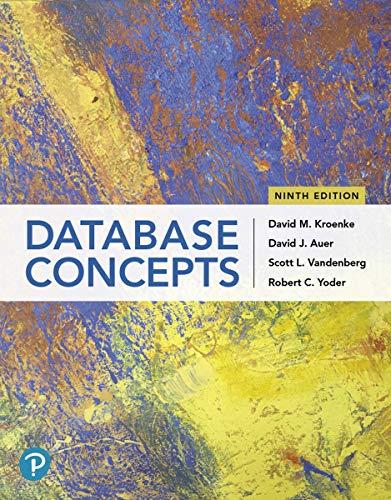Question
The owner of an Internet backbone network has two routers, A and B, interconnected by a single transcontinental communications link in the US operating at
The owner of an Internet backbone network has two routers, A and B, interconnected by a single transcontinental communications link in the US operating at T1 speeds (for this problem, assume T1 transmission speed, R, is exactly 1.5 Million bits/second (Mbps)). The physical length of this link is 5,000 kilometers and propagation speed over the link is 2.5 108 meters/second.
a) Calculate the one-way bandwidth-delay product for this link given by R Tpropagation (Tpropagation is the one-way propagation delay for the link).
b) Router A has 450,000 bits that are to be sent to router B stored in its buffers. Suppose these bits are transmitted to B in a continuous stream at rate R. What is the maximum number of bits that will be in the link at any one time?
c) Using the results from (a) and (b) give a brief discussion of what information is provided if one knows the bandwidth-delay product for a link.
d) What is the total end-to-end delay for transmitting all 450,000 bits in a continuous stream from router A to router B?
e) Suppose the 450,000 bits in buffers at router A are segmented into 50 frames of 9,000 bits each. Router A transmits the frames to B using a link-layer protocol that requires the sender to wait for an acknowledgement frame from the receiver (indicating that the senders frame n was received correctly) before the sender can send frame n+1. Assume the acknowledgement frame is very small so its transmission time is negligible and all frames sent are received correctly. Assuming the link speeds are completely symmetric in both directions, what is the total-end-to-end delay for transmitting all 450,000 bits from A to B in frames (the end-to-end delay interval ends when the last frame arrives at the receiver, not when the last acknowledgement returns to the sender)?
f) Suppose the link-layer protocol described in (e) is modified so the sender can send up to m frames of 9,000 bits each before it has to wait for an acknowledgement frame from the receiver (i.e., the sender can have up to m unacknowledged frames in flight to the receiver at any point in time). Assume that the link is full-duplex (the nodes at both ends of the link can transmit frames at the same time) and the link speeds are completely symmetric in both directions. What is the largest value of m such that an acknowledgement for frame 1 will arrive while frame m is being transmitted by the sender (the sender can then send frame m+1 immediately after m)? How soon after beginning to send frame 1 will the sender be able to begin sending frame m+1? How soon after beginning to send frame 1 will the sender be able to begin sending frame 2m? Assuming the sender can always maintain m frames in-flight, what is the total end-to-end delay for transmitting all 450,000 bits from A to B in frames? (Assume the end-to-end delay interval ends when the last frame arrives at the receiver and not when the last acknowledgement returns to the sender.)
g) the owner of the Internet backbone network described above has decided to upgrade the transcontinental link between routers A and B to OC-12 transmission speeds (the physical length of the link and its propagation speed remain at 5,000 kilometers and 2.5 108 meters/second, respectively). For this problem, assume that OC-12 transmission speed is exactly 600 Mbps. Provide answers to the questions in parts a, b, d, e, and f of question 2 for the OC-12 link.
Step by Step Solution
There are 3 Steps involved in it
Step: 1

Get Instant Access to Expert-Tailored Solutions
See step-by-step solutions with expert insights and AI powered tools for academic success
Step: 2

Step: 3

Ace Your Homework with AI
Get the answers you need in no time with our AI-driven, step-by-step assistance
Get Started


